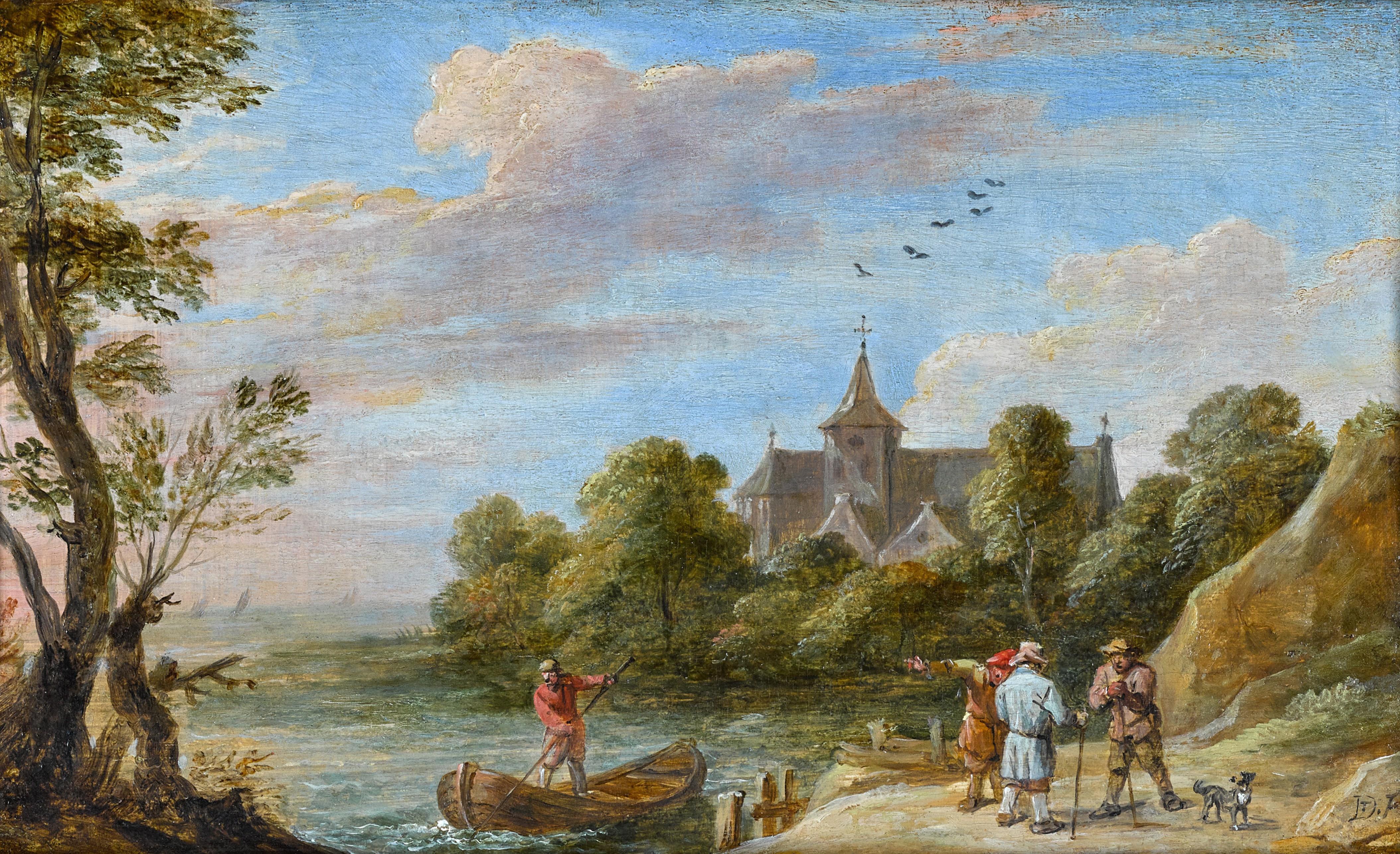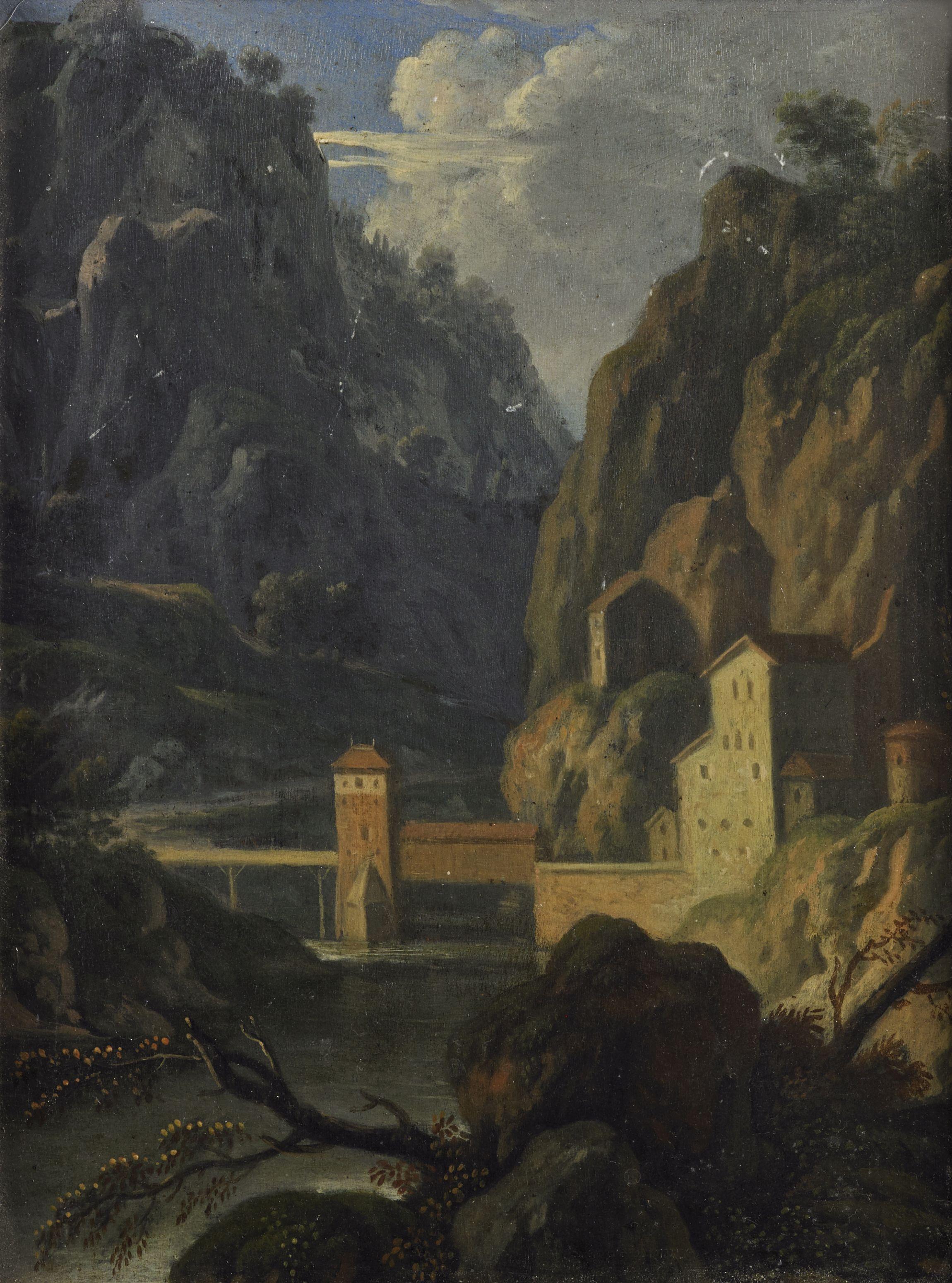Items Similar to The Judgement of Midas - Frans Francken II and Gijsbrecht Leytens
Want more images or videos?
Request additional images or videos from the seller
Frans Francken II (Antwerp 1581 - 1642)The Judgement of Midas - Frans Francken II and Gijsbrecht Leytens
About the Item
Oil on panel
Perfect condition
Housed in a 17th century style frame by Gehring Amsterdam framers
We are grateful to Ursula Härting for confirming the attribution of the present painting to Francken (figures) and Leytens (landscape). A written certificate, dated 1 February 2022, is available. She dates the present Midas to the second half of the 1620s.
The painting The Judgement of Midas, known to me in the original, was painted by Frans Francken the Younger and, based on today’s state of knowledge, by Gysbrecht Leytens. The figural staffage in the foreground is by the hand of Francken, while Leytens executed the landscape background with the followers of Pan […]. Since the eighteenth century, only wintery motifs featuring bare trees have been found as works by the Master of the Winter Landscapes or Leytens, but during his lifetime in the seventeenth century, one could also encounter plain landscapes, in one instance with figures by Francken’s hand, or even seascapes under that name. Recently, I have recognised Leytens’s hand in dense, woolly foliage and in pale green and very loosely painted leafy landscapes or parts thereof. Starting in March 1627, Leytens rented the studio of the deceased Govaerts for a period of three years. Leytens might have been able to complete unfinished paintings there at a stage when they solely featured staffage by the hand of Frans Francken II, such as probably the present picture, which I date to the second half of the 1620s. So far, the basis of a painting has been seen in its background, such as the present landscape, which would then have been followed by the figure painter’s contribution. With its figures by Frans II in the foreground, however, the present painting confirms that the landscape background was painted around the figural staffage, which had been there first.’
The judgement of Midas is part of Ovid's Methamorphoses and tells us the story of a music competition between faun Pan and Apollo (God of music and poetry).
Apollo won the contest but Midas then questioned this outcome and pointed out Pan -here seen as the lesser God- as winner. Midas was punished voor his foolish and frivolous judgement and therefore sentenced to his well known dog-ears. Similar moralising paintings were very popular in the Southern Netherlands. They were a form of triggering conversations and a demonstration of the intellectual knowledge (regarding mythology) of the owner or host.
- Creator:Frans Francken II (Antwerp 1581 - 1642) (1581 - 1642, Flemish, Belgian)
- Dimensions:Height: 22.45 in (57 cm)Width: 33.08 in (84 cm)
- Medium:
- Movement & Style:
- Period:
- Condition:
- Gallery Location:Gent, BE
- Reference Number:1stDibs: LU2239213535652
About the Seller
No Reviews Yet
Vetted Seller
These experienced sellers undergo a comprehensive evaluation by our team of in-house experts.
Established in 1999
1stDibs seller since 2022
- ShippingRetrieving quote...Ships From: Gent, Belgium
- Return PolicyThis item cannot be returned.
More From This SellerView All
- Animated harbor scene near a fortified palace - Matthijs SchoevaerdtsLocated in Gent, BEOil on panel Mathys Schoevaerdts is known for his landscape art and genre scenes. His landscapes are full of anecdotes and delicately painted scenes of peasants travelling, sailing ...Category
17th Century Flemish School Landscape Paintings
MaterialsOil, Wood Panel
- Two scenes showing a fish market in front of a town - Mathijs SchoevaerdtsLocated in Gent, BEOil on canvas Dimensions: 38 x 67 cm Schoevaerdt's specialty was combination landscapes, in which airy landscapes are often combined with a body of water and imaginative capricci...Category
17th Century Flemish School Paintings
MaterialsCanvas, Oil
- Landscape with travellers near a bridge - Attributed to Goffredo WalsLocated in Gent, BEOil on oval lime wood panel Collection number on the back: 272 We see a herd of goats and their shepherds on the bridge, one of the shepherds is on a horse, the others look at the men near the riverbank. Two standing figures are pointing and discussing with one another, while the other one is sitting and relaxing after a long trip. We'd like to thank dr. Guido Jansen for his attribution. Goffredo Wals was a German painter, who spent most of his career in Italy. Most of his works were in small format, often circular and painted on copper...Category
17th Century Old Masters Landscape Paintings
MaterialsOil, Wood Panel
- The Brothel - Attributed to Cornelis de Baellieur (Antwerp 1607 - 1671)Located in Gent, BEThe Brothel Oil on panel Tavern and brothel scenes were popular subjects in 17th-century Flemish art, depicting the vibrant and often rowdy social life of the time. The scenes wer...Category
17th Century Flemish School Interior Paintings
MaterialsOil, Wood Panel
- City view of the Graslei in Ghent - François Edouard Bertin (1797-1871)Located in Gent, BEOil on panel Signed lower right: "Bertin, 1870," Bertin was a French painter, he represented the details and general character of a landscape with great skill. On this painting we can see a view of the Graslei in Ghent. The Graslei is a quay in the historic city center of Ghent, Belgium, located on the right bank...Category
19th Century Romantic Landscape Paintings
MaterialsOil, Panel
- Portrait of a bearded man - Adriaen Thomasz. Key (c. 1544-1589)Located in Gent, BEOil on panel We are grateful to Koenraad Jonckheere for confirming the attribution after inspection of the original. He dates the work to circa 1570. The present portrait of a bearded man, arresting in its intimacy, capturing the contemplative gaze of the sitter, along with the intense naturalism with which his face is rendered, is an outstanding example of the oeuvre of the Antwerp master Adriaen Thomasz. Key. Attired in an expensive and modish ‘Burgundian black’ doublet...Category
16th Century Flemish School Portrait Paintings
MaterialsOil, Panel
You May Also Like
- Dutch or Flemish Landscape with Figures & AnimalsLocated in Milford, NHA beautifully detailed late 17th or early 18th century Dutch or Flemish landscape with cows grazing in the water, goats, dogs, and other animals near the water’s edge, under the watchful eye of the herdsmen, on a backdrop of rolling hills and trees. Oil on wood panel, unsigned, and housed in a Rudolph...Category
Late 17th Century Flemish School Landscape Paintings
MaterialsOil, Wood Panel
- A river landscape with travellers by a jetty and a man in a rowing boatBy David Teniers the YoungerLocated in Tallinn, EEDavid Teniers the Younger Antwerp 1610 - 1690 Brussels A river landscape with travellers by a jetty and a man in a rowing boat, a church beyond Signed with monogram lower right: DT. ...Category
17th Century Flemish School Landscape Paintings
MaterialsOak, Oil, Panel
- Antique Flemish Oil on Panel Francois Backvis Shepherd Sheep Flock Painting 1880By François BackvisLocated in Portland, ORA good antique oil on panel landscape painting by the Flemish artist, Francois Backvis (1857-1926). The painting circa 1880 depicting the parable of the lost sheep from the gospels of Matthew & Luke. The painting shows a stormy landscape with the shepherd and his flock, the shepherd is holding the lost sheep under his arm in front of a large stone crucifix...Category
Late 19th Century Flemish School Landscape Paintings
MaterialsOil, Panel
- 17th Landscape Flemish School Houses Bridge Trees Oil on Canvas Green BrownLocated in Sanremo, ITPainting, oil on panel, measuring 20 x 15 without frame and 35 x 30 with frame, depicting a landscape with a beautiful perspective and houses arranged on a mountain of the Flemish sc...Category
Late 17th Century Flemish School Landscape Paintings
MaterialsOil, Board
- 18th Century Landscape Flemish School People and Cows Oil on Canvas GreenLocated in Sanremo, ITFlemish painting measuring 44 x 30 cm without frame and 53 x 39 cm with frame depicting a landscape with figures, in soft tones and with a strong sense of perspective; elegant, fluid...Category
18th Century Flemish School Landscape Paintings
MaterialsCanvas, Oil
- Landscape with Rocky VistaLocated in London, GBOil on oak panel Image size: 6 1/4 x 6 1/4 inches (15.75 x 15.75 cm) Period ebonised frame Patinir’s poetic imagination allowed him to express an idealised world, or one steeped in pathos, with profound sentiments, and always with perfect technique. The level of detail in this work is astonishing and the viewer is sure to make new discoveries every time that they gaze upon it, such as the birds diving down from the rocky form or the spindly poles that hold up the bowing bridge. Patinir's landscapes recall the background landscapes in the work of his contemporary Netherlandish painters, such as Gerard David. His magnificent rendering of light and shadows also foreshadow the great Dutch masters of the 17th century; as well does his excellent use of colour—especially his delightful range of blues and greens. Together, these traits make his works both innovative and uncommonly attractive. Here, although the scene is populated, the figures are small and the landscape assumes increasing importance. Joachim Patinir Joachim Patinir, who was born on the banks of the Meuse River, is considered the first Flemish landscape painter. His vast, highly personal landscapes are characterized by large expanses of terrain with high horizons and fantastic outcroppings of pointed rock that combine real and symbolic. He is thought to have begun his career in Bruges, where he discovered the work of Gérard David, but like David, he appears on a list of Antwerp-based masters in 1515. There, he met and befriended Albrecht Dürer, who visited the Netherlands in 1520-1521. Dürer subsequently painted his portrait and even attended his daughter’s wedding. Patinir was also friends with Quintin Massys, who painted some of the figures in his works. Their friendship was so lasting that Massys’ son, Cornelis, apprenticed with Patinir. Cornelis eventually married Patinir’s daughter, Francisca Buyts, and the elder painter became their tutor. In 1521, Patinir remarried, this time to Jeanne Nuyts. His life was quite short, and he produced relatively few paintings, notwithstanding certain mediocre works erroneously attributed to him. His fame is due primarily to his final paintings, whose masterful technique and creativity were praised by his peers. In his travelogue, Dürer called him "a good landscape painter", and Felipe de Guevara, a friend and artistic assessor to both Charles V and Philip II, mentions him in his "Commentaries on Painting" (1540) as one of the three greatest painters, alongside Rogier van der Weyden and Jan van Eyck. His work was also very successful on the art market, especially when we recall that, in 16th-century Antwerp, artists did not work on commission. Instead, they sold finished works to their clients. From the very start, Patinir’s paintings reflect the influence of Hieronymus Bosch, although they lack that master’s satirical edge. He was also influenced by Gérard David, from whom he drew his perfect execution as well as his taste for landscape. His name appears on two early works—"Saint Jerome" (Staatliche Kunsthalle, Karlsruhe) and "The Flight to Egypt" (Koninklijk Museum voor Schone Kunsten, Antwerp)—but his inscriptions on three other panels—"The Baptism of Christ" (Kunsthistorisches Museum, Vienna), "Landscape with...Category
16th Century Flemish School Landscape Paintings
MaterialsOak, Oil




